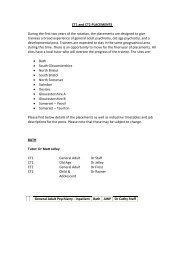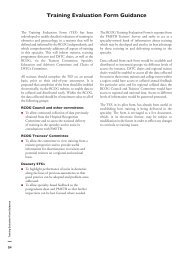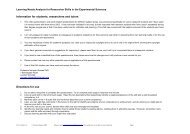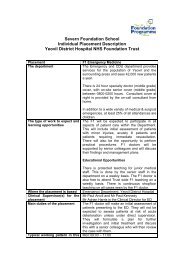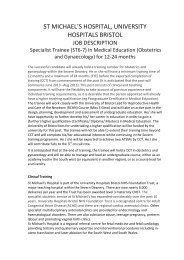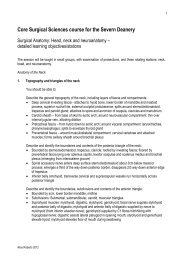Abdomen and Pelvis objectives - Surgery - Severn Deanery
Abdomen and Pelvis objectives - Surgery - Severn Deanery
Abdomen and Pelvis objectives - Surgery - Severn Deanery
You also want an ePaper? Increase the reach of your titles
YUMPU automatically turns print PDFs into web optimized ePapers that Google loves.
4<br />
Abdominal cavity <strong>and</strong> viscera<br />
1. Peritoneum, peritoneal cavity <strong>and</strong> compartments<br />
You should be able to describe the peritoneum:<br />
A thin serous membrane (similar to pleura <strong>and</strong> serous pericardium);<br />
Parietal <strong>and</strong> visceral layers; forms folds through which nerves <strong>and</strong> vessels reach the viscera<br />
Entire embryonic gut tube possesses a mesentery; some gut remains intraperitoneal <strong>and</strong> retains a<br />
mesentery, other parts become secondarily retroperitoneal<br />
Peritoneal fluid lubricates gut movement <strong>and</strong> expansion<br />
Visceral peritoneum innervated by autonomic afferents from viscera; parietal by somatic nerves<br />
Describe the omenta, greater <strong>and</strong> lesser sacs:<br />
Lesser omentum - double fold of peritoneum joining the lesser curvature of the stomach to the<br />
visceral surface of the liver (part of the embryonic ventral mesogastrium)<br />
Lesser sac (omental bursa) - peritoneal pouch behind the lesser omentum <strong>and</strong> stomach;<br />
communicating with the greater sac (peritoneal cavity) at the epiploic foramen; formed by rotation of<br />
stomach during embryological development<br />
Dorsal mesentery of stomach forms greater omentum, gastrosplenic <strong>and</strong> splenorenal ligaments<br />
The greater omentum – a quadruple fold of peritoneum hanging down over the intestines, <strong>and</strong><br />
attaching from the greater curvature of the stomach to the transverse colon; its two posterior layers<br />
adhere to the transverse mesocolon to form the posterior wall of lesser sac (surgically separable);<br />
contains fat <strong>and</strong> macrophages<br />
Splenic vessels <strong>and</strong> tail of pancreas in splenorenal lig<br />
Epiploic foramen (of Winslow) - vertical slit about 2.5cm long; anterior border formed by free edge of<br />
lesser omentum (containing portal vein posteriorly, bile duct <strong>and</strong> hep artery anteriorly, & autonomic<br />
nerves, lymphatics)<br />
Describe the peritoneal compartments <strong>and</strong> pouches:<br />
Supracolic compartment above attachment of transverse mesocolon (over body of pancreas);<br />
infracolic below (NB. traction on root of mesentery stimulates pressure receptors <strong>and</strong> causes reflex<br />
drop in BP)<br />
Supracolic compartment divided into right <strong>and</strong> left subphrenic/diaphragmatic spaces by falciform<br />
ligament – extend up as far as sup layer of coronary ligament on right <strong>and</strong> anterior layer of left<br />
triangular ligament on the left<br />
Right subhepatic space (or hepatorenal pouch) between lower layer of coronary ligament <strong>and</strong><br />
transverse mesocolon attachment (lowest part of cavity when supine – fluid accumulates here)<br />
Right paracolic gutter <strong>and</strong> right infracolic space lateral <strong>and</strong> medial to ascending colon, respectively<br />
Left paracolic gutter <strong>and</strong> left infracolic space lateral <strong>and</strong> medial to descending colon, respectively<br />
Left infracolic space cont with pelvic cavity<br />
Sigmoid mesocolon attaches down to S3 – then rectum<br />
Alice Roberts 2012



